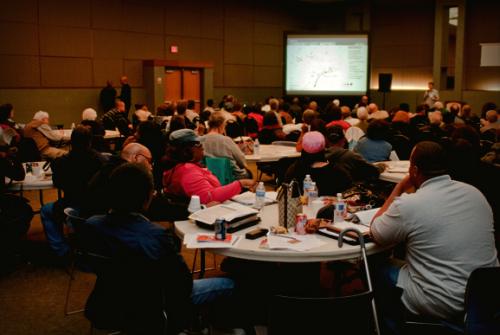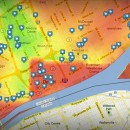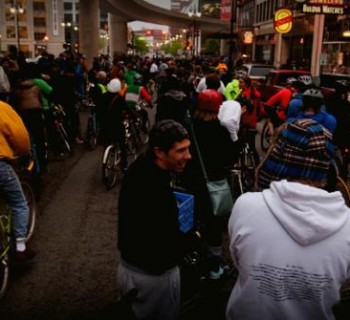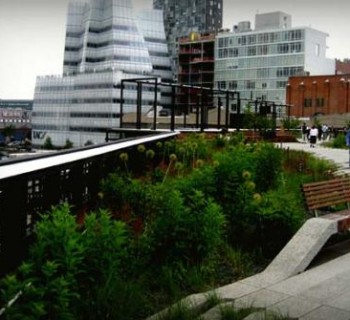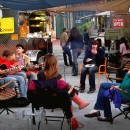DETROIT — Detroit Works Project is trying.
Sitting in a banquet hall at the Northwest Activities Center on Detroit’s northwest side May 7, about 100 citizens sat listening to planners and organizers about updates on the long-term future of the city.
During the two-hour meeting, which was the second installment of a series of three, residents asked University of Detroit-Mercy’s Dan Pitera and Daniel Kinkead of downtown Detroit-based Hamilton Anderson Associates (HAA) questions about participation and the planning process for Detroit.
It was one of four meetings for Pitera and Kinkead that week. They held these same meetings at four different regions throughout Detroit, the other regions being the Southwest, Northeast and Central areas of the city.
The information DWP offered during the Phase 2 conversation, which was organized for citizens as an idea-generating session and planning update, offered many statistics and diagrams about tentative solutions and plans. Many attendees, however, thought the information was vague and lacked clarity.
Charles Harvey, an 80-year-old resident who lives near 7 Mile Rd. and Wyoming Rd., says, “I hear words. They’re good slogans, but what do they mean? It sounds like a private organization is going about deciding what’s best for Detroit.”
The “private organization” Harvey speaks of is DWP’s Steering Committee. While not actually private, the Mayor-appointed 13-member panel is meant to provide long-term leadership and oversee the project on the city's behalf.
Pitera is the executive director of the Detroit Collaborative Design Center (DCDC) at UDM’s School of Architecture. He leads the civic engagement team, which is made of DCDC employees, representatives of Community Legal Resources (CLR) as well as other volunteers, who serve as process leaders and project ambassadors. (Read more about process leaders here.)
Toni L. Griffin, founder of Urban Planning and Design for the American City, leads the technical team, which is comprised of representatives from HAA, Happold Consultants, Initiative for Competitive Inner City, and others.
The Steering Committee, in turn, is advised by the Mayor’s 51-member Advisory Task Force, with five chairs, which represent the general interests of the community.
“They’re deciding what’s best for Detroit,” Harvey says. “You can meet and have some nice words, but what is their ultimate objective?”
Reporting regularly to Mayor Dave Bing, all these committees, teams and task forces ultimately want to solicit feedback from citizens at the Community Conversations and construct a “strategic framework plan”, a tool to be used by city officials, residents and community organizations to help guide the city’s future development, specifically the distribution of city services.
Detroit Works Project 1.0
When Detroit Mayor Dave Bing first introduced the Detroit Works Project in fall 2010, the meetings held were centered on how to best provide citizens in sparsely populated neighborhoods with city services in an efficient manner.
While part of this plan may have originally included the idea of relocating citizens into a denser urban core in order to provide those services, DWP spokesperson James Canning says that has never been a focal point of the Mayor’s plan, nor were they considering forcing anyone out of their homes.
“A lot of Sponsored Community Organizations have websites, Facebook pages, Twitters – there are so many new mediums out there. There’s no excuse. A lot of people have been left out and have no clue what this is about.”
The city has claimed they won’t use eminent domain to restructure the city, but there have been talks about enticing residents to move with incentives. The city has also said they plan on demolishing 10,000 houses in the next four years, mostly throughout "distressed neighborhoods," as the city has dubbed them, which have been classified by "long-term physical decline, little or no market activity and high vacanacy rates."
Called “rightsizing” by the media during initial coverage, the focus of the Mayor’s Long-Term Planning strategy is not necessarily to relocate citizens, but how to better strategize the distribution and implementation of services. City officials have avoided using the term rightsizing and have rather referred to it as a “land-use plan.”
Bing has suggested in the past, however, that relocating residents from blighted to healthy neighborhoods would absolutely be part of the land-use restructuring.
“You might want to do that,” Harvey says. “But a lot of these seniors … have paid for their homes and can live in them the rest of their lives. They can’t afford to move anywhere else -- and if they did they probably wouldn’t live very long because they’re tied to those neighborhoods.”
In the very first rounds of meetings, which were really the only channel for community outreach and input, thousands of residents showed up, many confused about Bing’s idea to relocate citizens, and many were just plain angry.
"The engagement done in the first iteration of Detroit Works was important and very helpful. It got us to this point and provided some great input from the community that has been utilized to create the trends and imperatives being used in this iteration," says Charles Cross, director of integreation for the Civic Engagement team for DWP. "The approach to civic engagement is different from the standpoint that we are utilizing numerous tactics to engage a broad range of Detroiters."
Since 2011, Bing has restructured DWP into its current form, and meetings seem to be going smoother. However, there are now two parts to Detroit Works Project: Long-Term Planning, which is lead by the Steering Committee, and Short-Term Actions, which the city says was implemented with the goal of immediately addressing problems of distressed neighborhoods and showcasing Detroit’s steady neighborhoods.
According to the City’s website, they have identified three “Demonstration Areas” where they are reconfiguring city services and "leveraging investments," while also working with the community to improve the market conditions in those areas. They have paved roads, replaced or fixed over 2,000 streetlights and removed illegal dumping sites.
“Those people who live in those communities are some of the more affluent people in this city,” Harvey says. “Why are we trying to save their home? That’s the whole problem – we shouldn’t give somebody $75,000 to repair their $300,000 home.”
New Community Engagement
Diane Butler, 66, has been living in Detroit since the 1940s and says most of the people in attendance at these meetings have no idea how Detroit works.
“They’re making an effort,” Butler says. “Any effort is better than no effort. They can’t solve the problem in a day.”
“They all want something but they’re not willing to make the sacrifices they have to make,” Butler says. “They don’t want to get up and do something. You have to actively work – you have to clean up that empty street, that bad lot.”
“Most of these people, who are younger, who are complaining, created the problem,” she says. “They get their education and then they leave … they want to live outside the ‘bad area.’”
But Harvey sees it differently.
“There are a lot of community presidents who are busy trying to keep the neighborhoods safe with patrols, and making sure people are taking care of their properties,” he says. “We’re doing what we’re supposed to be doing, so why are we being ignored?”
Butler and Harvey both agree, however, DWP does need to involve more citizen groups.
Acting as vice president of the MacDowell Community Radio Patrol, the fifth community radio patrol in Detroit’s 12th Precinct, Harvey says he didn’t know about the Community Conversation until the day of the event.
“I would go to the neighborhood city hall and see who the community leaders were,” he says. “We all have to register with neighborhood city hall. Get a list from them and then send it out [to the leaders and their networks.] That’s how I would promote these meetings.”
Marcus Cummings, a 24-year-old member of the Schaefer 7/8 Lodge Association, agrees. “There’s not as much community involvement as I would like to see.”
“Hopefully in the future they do a better job of getting the information out there,” Cummings says. “A lot of Sponsored Community Organizations have websites, Facebook pages, Twitters – there are so many new mediums out there. There’s no excuse. A lot of people have been left out and have no clue what this is about.”
“I called the Mayor’s office today, and they said if you want to know about [DWP] you have to be a part of the website,” says Winfred Blackman, 66, also with the Schaefer 7/8 Lodge Association. “How are you going to know about it if you don’t publicize it?”
Butler thinks it’s important to also entice younger age groups. “The older people know what’s wrong with the city,” she says. “We need more citizens groups and a more diverse age group,” says Butler of those in attendance at the meeting, most of who appeared above the age of 45.
Detroit 24/7, engagement and analysis
Launched in early May, the Detroit 24/7 game is an online platform designed to engage younger Detroiters by turning the planning process into more a game-type structure, which DWP's Long Term Planning team hopes will make the process more interesting.
Engagement Game Lab developed the gaming platform, called Community PlanIt, and Detroit is one of four cities using it. Funded by the John S. and James L. Knight Foundation, the beta project was developed for the iPad and is also being used by Boston, Philadelphia, and Akron, Ohio. If successful, Community PlanIt will likely be used by cities across the country in their planning efforts.
“We have also sought the advice and guidance along the way of 15 “Process Leaders”, who have helped shape how we engage with residents,” Cross says.
Priya Iyer, who is director of digital engagement for Detroit Works Project Long Term, says while they won’t compile statistics on who uses 24/7 until the project has ended, “the types of participants indicates that the demographic is wide. It appears the age span [is] from high school to senior citizens, and many socio-economic backgrounds are represented.”
According to DWP Long Term, Detroit 24/7 is just one facet of their engagement strategy.
Cross says the Long Term facet is talking to community leaders across the city. “We want as many people as possible to have a voice in the process,” he says. “[We have] our roaming table, our digital gaming component … [we] attend existing meetings so the community understands we want to become a part of their agenda.” He says they also receive input through DWP's Long Term Planning street team, ambassadors, roundtable meetings and community conversations, “just to name a few.”
“We have also sought the advice and guidance along the way of 15 'Process Leaders', who have helped shape how we engage with residents,” Cross says.
Through the first two Community Conversations, where citizens offered input on what they see as priorities to fix the city, DWP Long Term compiled 14 Quality of Life Elements that need to be addressed, which focus on issues like safety, health, education, prosperity, mobility, recreation and others. With those 14 elements, the Long Term staff also formulated 12 “Imperatives,” or, actions that must be taken to improve quality of life in Detroit, as well as a series of Building Blocks that will be used to address land-use concerns.
In all, Cross says the strategic framework being developed from input at these meetings will be used as a tool for how the city addresses quality of life factors for Detroiters.
DWP nears the end of the third round of Community Conversations
Pitera, Cross and the rest of the DWP team just finished their third round of Community Conversations, which focused on implementation strategy.
According to a DWP press release, attendees at the first two conversations held in four regions of Detroit learned about the work being done by the technical planning team, specifically the aforementioned Quality of Life Elements and the 12 Imperatives.
“A lot of the technical planning team's work was shared with Detroiters during the first two conversations,” said Christianne Sims, a Process Leader for the project who has helped lead the conversations. “The third one will be a chance for residents and other Detroit stakeholders to use that information, along with the expertise they have as members of our community, to offer their suggestions for strategies they’d like to see incorporated into the strategic framework plan.”
“Once the third-round of conversations is complete, that does not mean we are done with the project,” says Pitera in a press release. “There is still plenty of work to do. The next steps will be for us to analyze the feedback and the technical team to begin using it as they draft the recommendations for the framework plan. During this time, the engagement activities will continue; we will be sharing what has been done.”
With completion of the entire project expected in August, DWP hopes the framework will incorporate shared visions for the city and neighborhoods; public policy recommendations that include revisions to the city’s Master Plan and zoning ordinances; and implementation strategies, which can be carried out by the city government, business, residents and community-based organizations.
Through all the uncertainty and back-and-forth, one thing is for sure: no citizen or member of the Detroit Works Project has a pothole-free ride to Easy Street – everyone is bound to bend a rim and blow out a tire at some point along the ride. What really matters is how one deals with those challenges and whether or not they can keep their cool.
“They’re making an effort,” Butler says. “Any effort is better than no effort. They can’t solve the problem in a day.”


